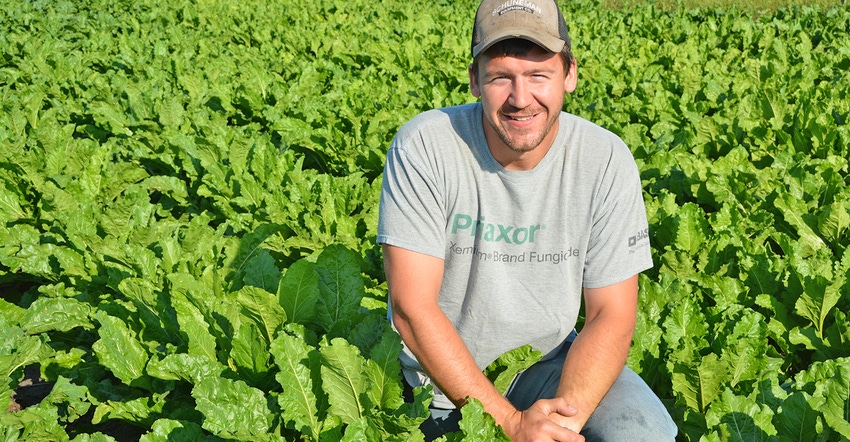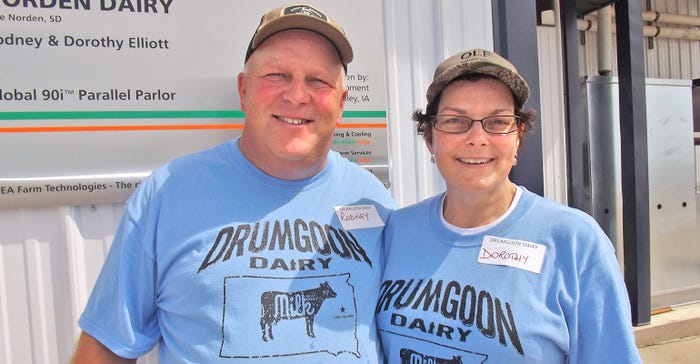February 2, 2018

By some people’s definition of sustainable agriculture, Carson and Haley Klosterman Farms Partnership, of Wyndmere, N.D., and Drumgoon Dairy, of Lake Norden, S.D., can’t be called sustainable.
CHK Farms raises a couple thousand acres of sugarbeets, corn and soybeans. Drumgoon Dairy milks 4,000 cows in barns as big as warehouses. Critics would call both of them industrial or factory farms.
But the families who own and operate them, say their farms are sustainable and they strive to improve their sustainability every day.
CHK Farms
Carson Klosterman, 31, is the fourth generation to operate his family’s farm in southeast North Dakota in the Red River Valley.
Like a lot of Dakota farmers and ranchers, Carson defines being sustainable first as being profitable so he and his wife, Haley, can make a living on the land and eventually pass on a viable business to their son or daughter. He also wants to leave the land in better shape than it was when he started farming it.
And Carson wants to do it voluntarily. He doesn’t want the government issuing rules and regulations on how to farm.
“You want to be doing it already,” says Carson, who is president of the North Dakota Corn Growers Association and has been involved in local and national sustainability initiatives.
Every generation of the Klostermans has tried to improve the land. Each, he says, did the best they could with the tools they had. His great-grandfather used green manure fallow crops, but plowed them under because there were no herbicides to control weeds. His grandfather scraped out surface drainage ditches to manage water because tiling systems for their nearly level fields wasn’t available
Today, Carson is using no-till, strip-till and cover crops. His first step was to tile fields so he can remove excess water from the soil so they don’t have to till fields to dry them out. Now they can strip-till and no-till instead.
“Tiling has made conservation tillage possible on our farm,” Carson says.
Strip-till and no-till leave more crop residue on the soil surface than conventional tillage. The residue is armor that protects the soil from wind and water erosion. It cuts the amount of soil moisture lost through evaporation and reduces peak soil temperatures in the summer. No-till and strip-till preserve the soil’s structure, which protects earthworms and other organisms living in the soil.
Carson also plants cover crops. But cover crops aren’t something new to the farm. His father started planting rye strips on sugarbeet fields to prevent soil erosion and wind damage to sugarbeet seedlings in the spring.
Since about 2008, Carson has been using cover crops in corn and soybeans, too. He discovered the power of cover crops when he had to manage prevent plant fields. Rather than tilling them and leaving the soil bare all year, they planted cover crop mixes. The following spring those fields were dry enough to plant, while others where they used tillage were still too wet to plant. The grain crops planted in the cover crop residue were excellent, too. Yields were as high as or higher than their other fields.
Carson now plants cover crops on as many fields as he can, not just the ones that are prevent plant. He put together parts from several different short-line equipment companies to make an interseeder, which he uses to plant cover crop into growing corn, sugarbeets and soybeans. The seed germinates after it rains, but the shaded seedlings remain small until the grain or beet canopy thins as the crop matures. Then the cover crops begin to grow and become well established by the time the corn, soybeans and beets are harvested. Interseeding gives them several extra weeks of cover crop growth.
With strip-till, no-till and cover crops, CHK Farms has maintained or increased its grain and beet yields while cutting fuel, chemical and fertilizer inputs. The soil is producing more of the nutrients that the crop needs, even as it builds organic matter. But for all they have accomplished, Carson often wonders about else they can do.
He’s interested in relay cropping — harvesting two crops on the same land in same growing season. It’s common in the southern U.S., but not in the Northern Plains. It may be possible to plant early maturing soybeans after harvesting winter wheat early, he says.
Carson also wants to get livestock back on their land. Beef cows could graze cover crops and crop residue in the fall or spring. Carson’s family has not had cattle themselves for many years, but he could form partnerships with neighbors who have livestock.
“It would be a good for our whole community,” he says,
Drumgoon Dairy
To Rodney and Dorothy Elliott, and their son, David, who operate Drumgoon Dairy, being sustainable means caring — caring for the environment, their animals, their employees and their community.
The success of every dairy — large or small — depends first on caring for the cows, says Rodney, who used to operate a small dairy in Ireland before moving to South Dakota.
“From the first cow I owned in Northern Ireland to every cow on our farm in South Dakota, the cows always come first,” Rodney says. “Farm size doesn’t matter when it comes to taking care of our animals. We all have to have the best practices and equipment and pay attention to every detail.”
The Elliotts are always looking for ways to improve their facilities and management practices to be more efficient. They designed their barns and buildings to allow for the most natural air viagra prank flow, which reduces the need for fans or ventilation systems. They installed energy-efficient LED lighting and energy-efficient water heaters through the facilities. They recycle water, sand bedding and other materials.
 DAIRY CARES: Rodney and Dorothy Elliott operate a large dairy. For them, sustainability revolves around caring – caring for their cows, land and employees.
DAIRY CARES: Rodney and Dorothy Elliott operate a large dairy. For them, sustainability revolves around caring – caring for their cows, land and employees.

“In almost every case, when we make a change that improves efficiency for the dairy, it also results in definite environmental and sustainability benefits,” Rodney says.
Manure from the dairy’s cows is an important natural fertilizer for land owned by the Elliotts and other local crop farmers that produce corn silage for the dairy’s feed. The manure is stored in lagoons at the dairy, then pumped through large hoses and applied directly into the farmland twice a year to fertilize the corn silage grown to feed the cows.
The Elliotts raise the vast majority of their corn silage within three miles of the dairy, because it requires less trucking and fuel, and results in less wear and tear on local roads. It also reduces the cost of fertilizer application.
“We are able to pass along some of those cost savings as price premiums to the local corn farmers who grow our silage,” Rodney says. It help them corn prices are low.
Drumgoon Dairy has 50 employees.
“We’ve had a lot of success in moving employees into jobs where they can grow their skills,” says Dorothy, who is the dairy’s administrator and human resources manager. They provide on-the-job training for animal handling, milking and other jobs and encourage additional training at local colleges for animal science, veterinary care and other important skills.
The Elliotts say they have built a business that they hope will sustain their family and their employees, and help sustain their community for many years to come.
The Midwest Dairy Association provided the section on Drumgoon Dairy.
You May Also Like




